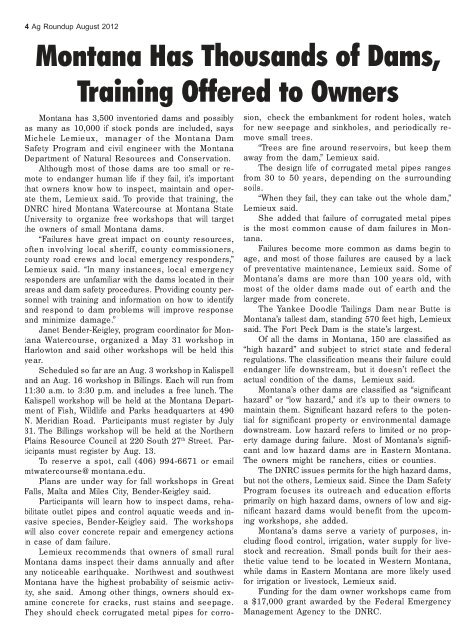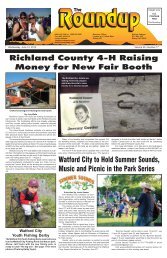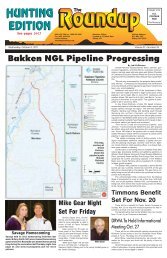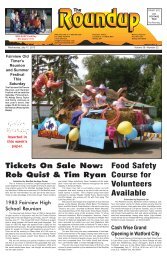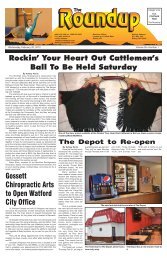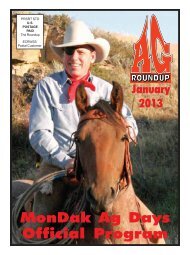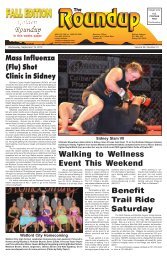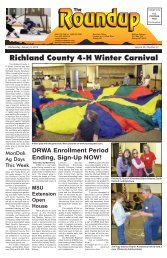to view. - The Roundup
to view. - The Roundup
to view. - The Roundup
Create successful ePaper yourself
Turn your PDF publications into a flip-book with our unique Google optimized e-Paper software.
4 Ag <strong>Roundup</strong> August 2012<br />
Montana Has Thousands of Dams,<br />
Training Offered <strong>to</strong> Owners<br />
Montana has 3,500 inven<strong>to</strong>ried dams and possibly<br />
as many as 10,000 if s<strong>to</strong>ck ponds are included, says<br />
Michele Lemieux, manager of the Montana Dam<br />
Safety Program and civil engineer with the Montana<br />
Department of Natural Resources and Conservation.<br />
Although most of those dams are <strong>to</strong>o small or remote<br />
<strong>to</strong> endanger human life if they fail, it’s important<br />
that owners know how <strong>to</strong> inspect, maintain and operate<br />
them, Lemieux said. To provide that training, the<br />
DNRC hired Montana Watercourse at Montana State<br />
University <strong>to</strong> organize free workshops that will target<br />
the owners of small Montana dams.<br />
“Failures have great impact on county resources,<br />
often involving local sheriff, county commissioners,<br />
county road crews and local emergency responders,”<br />
Lemieux said. “In many instances, local emergency<br />
responders are unfamiliar with the dams located in their<br />
areas and dam safety procedures. Providing county personnel<br />
with training and information on how <strong>to</strong> identify<br />
and respond <strong>to</strong> dam problems will improve response<br />
and minimize damage.”<br />
Janet Bender-Keigley, program coordina<strong>to</strong>r for Montana<br />
Watercourse, organized a May 31 workshop in<br />
Harlow<strong>to</strong>n and said other workshops will be held this<br />
year.<br />
Scheduled so far are an Aug. 3 workshop in Kalispell<br />
and an Aug. 16 workshop in Billings. Each will run from<br />
11:30 a.m. <strong>to</strong> 3:30 p.m. and includes a free lunch. <strong>The</strong><br />
Kalispell workshop will be held at the Montana Department<br />
of Fish, Wildlife and Parks headquarters at 490<br />
N. Meridian Road. Participants must register by July<br />
31. <strong>The</strong> Billings workshop will be held at the Northern<br />
Plains Resource Council at 220 South 27 th Street. Participants<br />
must register by Aug. 13.<br />
To reserve a spot, call (406) 994-6671 or email<br />
mtwatercourse@montana.edu.<br />
Plans are under way for fall workshops in Great<br />
Falls, Malta and Miles City, Bender-Keigley said.<br />
Participants will learn how <strong>to</strong> inspect dams, rehabilitate<br />
outlet pipes and control aquatic weeds and invasive<br />
species, Bender-Keigley said. <strong>The</strong> workshops<br />
will also cover concrete repair and emergency actions<br />
in case of dam failure.<br />
Lemieux recommends that owners of small rural<br />
Montana dams inspect their dams annually and after<br />
any noticeable earthquake. Northwest and southwest<br />
Montana have the highest probability of seismic activity,<br />
she said. Among other things, owners should examine<br />
concrete for cracks, rust stains and seepage.<br />
<strong>The</strong>y should check corrugated metal pipes for corro-<br />
sion, check the embankment for rodent holes, watch<br />
for new seepage and sinkholes, and periodically remove<br />
small trees.<br />
“Trees are fine around reservoirs, but keep them<br />
away from the dam,” Lemieux said.<br />
<strong>The</strong> design life of corrugated metal pipes ranges<br />
from 30 <strong>to</strong> 50 years, depending on the surrounding<br />
soils.<br />
“When they fail, they can take out the whole dam,”<br />
Lemieux said.<br />
She added that failure of corrugated metal pipes<br />
is the most common cause of dam failures in Montana.<br />
Failures become more common as dams begin <strong>to</strong><br />
age, and most of those failures are caused by a lack<br />
of preventative maintenance, Lemieux said. Some of<br />
Montana’s dams are more than 100 years old, with<br />
most of the older dams made out of earth and the<br />
larger made from concrete.<br />
<strong>The</strong> Yankee Doodle Tailings Dam near Butte is<br />
Montana’s tallest dam, standing 570 feet high, Lemieux<br />
said. <strong>The</strong> Fort Peck Dam is the state’s largest.<br />
Of all the dams in Montana, 150 are classified as<br />
“high hazard” and subject <strong>to</strong> strict state and federal<br />
regulations. <strong>The</strong> classification means their failure could<br />
endanger life downstream, but it doesn’t reflect the<br />
actual condition of the dams, Lemieux said.<br />
Montana’s other dams are classified as “significant<br />
hazard” or “low hazard,” and it’s up <strong>to</strong> their owners <strong>to</strong><br />
maintain them. Significant hazard refers <strong>to</strong> the potential<br />
for significant property or environmental damage<br />
downstream. Low hazard refers <strong>to</strong> limited or no property<br />
damage during failure. Most of Montana’s significant<br />
and low hazard dams are in Eastern Montana.<br />
<strong>The</strong> owners might be ranchers, cities or counties.<br />
<strong>The</strong> DNRC issues permits for the high hazard dams,<br />
but not the others, Lemieux said. Since the Dam Safety<br />
Program focuses its outreach and education efforts<br />
primarily on high hazard dams, owners of low and significant<br />
hazard dams would benefit from the upcoming<br />
workshops, she added.<br />
Montana’s dams serve a variety of purposes, including<br />
flood control, irrigation, water supply for lives<strong>to</strong>ck<br />
and recreation. Small ponds built for their aesthetic<br />
value tend <strong>to</strong> be located in Western Montana,<br />
while dams in Eastern Montana are more likely used<br />
for irrigation or lives<strong>to</strong>ck, Lemieux said.<br />
Funding for the dam owner workshops came from<br />
a $17,000 grant awarded by the Federal Emergency<br />
Management Agency <strong>to</strong> the DNRC.


